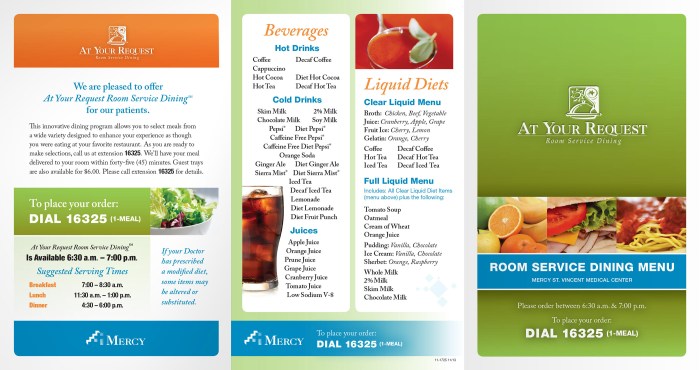A hospital in room menu may offer servsafe – A hospital in-room menu may offer ServSafe, an internationally recognized food safety certification program that empowers healthcare foodservice staff with the knowledge and skills to ensure the safe handling and preparation of food for patients. This program plays a vital role in upholding the highest standards of food safety in hospital settings, where patient well-being is paramount.
ServSafe certification entails comprehensive training in food safety principles, hazard analysis, and critical control points (HACCP). By equipping staff with this expertise, hospitals can proactively prevent foodborne illnesses, ensuring that patients receive safe and nutritious meals that contribute to their recovery and overall health.
ServSafe Training and Certification
ServSafe certification is an essential credential for hospital foodservice staff to ensure the safety and well-being of patients. The ServSafe training program provides comprehensive education on food safety principles, hazard analysis, and critical control points (HACCP).
Benefits of ServSafe Certification
- Enhanced food safety knowledge and skills
- Improved food handling and preparation practices
- Reduced risk of foodborne illnesses
- Compliance with regulatory standards
Examples of ServSafe Certification Impact, A hospital in room menu may offer servsafe
Studies have shown that hospitals with ServSafe-certified staff have significantly lower rates of foodborne illness outbreaks.
Food Safety Protocols in Hospital Room Menus

Hospital room menus must adhere to strict food safety protocols to prevent contamination and ensure patient safety.
Temperature Control
Foods must be maintained at proper temperatures to prevent the growth of bacteria. Hot foods should be kept above 145°F (63°C), while cold foods should be kept below 41°F (5°C).
Proper Storage
Foods should be stored in clean, dry, and temperature-controlled environments to prevent spoilage and contamination.
Cross-Contamination Prevention
Raw and cooked foods must be kept separate to prevent cross-contamination. Separate utensils and equipment should be used for handling different types of foods.
Examples of Food Safety Protocols
Hospitals may implement color-coded cutting boards and utensils to prevent cross-contamination, and use time-temperature logs to monitor the temperature of foods.
Menu Design for Patient Needs

Hospital room menus should be designed to meet the specific nutritional needs of patients.
Providing Variety
Menus should offer a variety of options to accommodate different dietary restrictions, such as allergies, intolerances, and religious preferences.
Nutritional Considerations
Foods should provide the necessary nutrients for patients to recover and maintain their health. Menus should include a balance of protein, carbohydrates, fats, vitamins, and minerals.
Examples of Patient-Centered Menus
Hospitals may consult with registered dietitians to develop menus that meet the specific needs of different patient populations.
Communication and Patient Education
Effective communication between foodservice staff and patients is crucial for menu management.
Patient Education
Patients should be informed about the menu options and any dietary restrictions. They should also be educated on the importance of food safety.
Staff Communication
Foodservice staff should be trained to communicate clearly and respectfully with patients. They should be able to answer questions and provide assistance.
Examples of Communication and Education
Hospitals may use patient portals or bedside tablets to provide patients with information about the menu and food safety practices.
Technology in Room Menu Management: A Hospital In Room Menu May Offer Servsafe
Technology can enhance room menu management in hospitals.
Online Ordering Systems
Online ordering systems allow patients to place orders from their bedsides. This can improve efficiency and patient satisfaction.
Mobile Apps
Mobile apps can provide patients with access to the menu, nutritional information, and other services.
Patient Portals
Patient portals can integrate with room menu systems, allowing patients to view menus, place orders, and communicate with foodservice staff.
Examples of Technology in Room Menu Management
Some hospitals have implemented QR code scanning systems that allow patients to access the menu and place orders.
Sustainability and Environmental Considerations

Sustainability and environmental considerations are becoming increasingly important in hospital room menu management.
Local and Seasonal Produce
Using local and seasonal produce reduces transportation emissions and supports local farmers.
Food Waste Reduction
Hospitals can implement programs to reduce food waste, such as composting and donating excess food.
Eco-Friendly Packaging
Using eco-friendly packaging materials can reduce waste and protect the environment.
Examples of Sustainable Practices
Some hospitals have partnered with local farms to source fresh produce, and have implemented composting programs to reduce food waste.
Essential FAQs
What are the benefits of ServSafe certification for hospital foodservice staff?
ServSafe certification provides hospital foodservice staff with the knowledge and skills to handle and prepare food safely, reducing the risk of foodborne illnesses and ensuring patient safety.
How does a hospital in-room menu that follows ServSafe protocols contribute to patient well-being?
By adhering to ServSafe protocols, hospitals can ensure that patients receive safe and nutritious meals that support their recovery and overall health, promoting their well-being during their hospital stay.
What role does technology play in enhancing room menu management in hospitals?
Technology, such as online ordering systems and mobile apps, can streamline the room menu process, improve efficiency, and enhance patient satisfaction by providing convenient and personalized dining options.